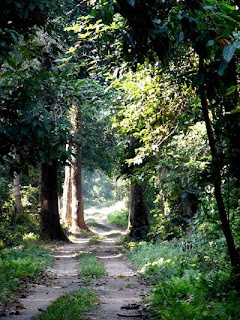.jpg) I went for a weeklong tour of the forested parts of North Bengal with my parents after my Class X Board Exams in 2006. We stayed at a forest lodge at Rajabhatkhawa and embarked on our tour of the Reserve which is at a distance of about 12 to 15 k.m. from Rajabhatkhawa. The Buxa Tiger Reserve, situated in the Northern parts of West Bengal in the district of Jalpaiguri, was set up as a Tiger Reserve in 1982-83 and was declared a National Park in 1992. It is rich in bio-diversity and is home to several species of animals, birds, insects and plants. The Reserve has an area of 761 sq km.
I went for a weeklong tour of the forested parts of North Bengal with my parents after my Class X Board Exams in 2006. We stayed at a forest lodge at Rajabhatkhawa and embarked on our tour of the Reserve which is at a distance of about 12 to 15 k.m. from Rajabhatkhawa. The Buxa Tiger Reserve, situated in the Northern parts of West Bengal in the district of Jalpaiguri, was set up as a Tiger Reserve in 1982-83 and was declared a National Park in 1992. It is rich in bio-diversity and is home to several species of animals, birds, insects and plants. The Reserve has an area of 761 sq km.The forest has about 33 Royal Bengal tigers, around 90 Indian elephants, 234 species of birds, 144 species of orchids, and other kinds of flora and fauna. The Forest is open for tourists from 15th September to 15th June. The forests are out of bounds during the monsoons.
The Forest Guide who was conducting our tour of the forest gave us a good account of the ways of the wild and the rules that one must not break while in the forest. He advised us not to click too many pictures as the flash of the light may blind the animals and would amount to wildlife “teasing”. Even talking loudly is prohibited inside the forest as that would again amount to “teasing”. As for that matter once one is inside the Reserve one quietens instinctively, as if the sound of the forest, the quiet rustle of the leaves of the huge Sal trees and the closely knit foliage prohibiting any light to seep through the curtain of green, the steady sound of crickets, commands us to maintain a reverential peace. The enormity of the trees could take your breath away.
A single tour through the forest can teach you to be observant of Nature. While touring the forest we saw that there were paths which went farther into the denser regions of the forest. When we wanted to know where those paths led to the Guide told us that those were not paths which we could take because those were Elephant’s Corridor, the paths which the elephants created for themselves and that the elephants never deviated from these passages. We also saw a cricket, the insect almost famed for its invisibility, sitting on a low branch of a tree. Withered Sal trees were left decomposing and the Guide informed us that no one could collect wood from these dead trees as even the dead trees were home to microorganisms necessary to maintain the ecology of the forest. We saw a lizard like animal, about a foot and a half long, with black scaly skin striped with yellow; it could have been an oversized lizard or a small snake that had grown limbs. After touring through the forest for a couple of hours we came across an open space which was a salt pit. A watch tower was nearby and our Guide told us that if we could spend the night in that watch tower we could have seen elephants, and deer coming down to this salt pit. Although we did not see any tigers, because of the obvious reason that that there were only 33 tigers in that 761 sq km area, we did see several deer, and heard different kinds of birds. But I can remember most distinctly the sound made by a kind of insect, a species of crickets making the sound of bells ringing in a temple. Our Guide said that poaching was controlled to a large extent by the forest patrols. Another thing that caught my eye was a small kit-bag which the Guide was holding very dear to himself. I asked him what the bag contained and he showed me a compass, some candles, matches, a torch and a few patakhas. This bag is for emergency uses, and there can be only one kind of emergency in the forest, which is if you are lost! The Patakhas are meant to scare away wild animals but they are used only as a last resort because on one hand you may scare away the danger at hand but the waves of the sound may attract other animals.
Several new schemes have been started in this Reserve. India Eco-development Project funded by World Bank under the Global Environment Facility is functioning in the Reserve. It contains components for village eco-development, extension and improved education and research. There are 62 Forest Protection Committee (FPC)/ Eco-Development Committee (EDC) in and around the Reserve. Buxaduar and Rajabhatkhawa are two main centres which have developed over the years for ecotourism or nature education tourism. This Reserve has attracted tourists and nature lovers and a Nature Interpretation Centre has been set up recently at Rajabhatkhawa.
No comments:
Post a Comment